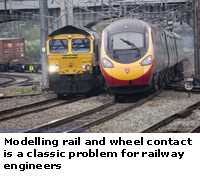New software will help rail industry predict track damage
18/12/2008
 A new computer modelling programme which aims to improve rail safety by predicting more accurately the wear and tear on rail tracks is being developed by Manchester Metropolitan University and Phoenix Inspection Systems.
A new computer modelling programme which aims to improve rail safety by predicting more accurately the wear and tear on rail tracks is being developed by Manchester Metropolitan University and Phoenix Inspection Systems.The project is a joint venture between the university's Rail Technology Unit and Phoenix, which manufactures ultrasonic non-destructive testing equipment. Software developed by the university will be tested for accuracy by comparing its predictions to the results of trials conducted by Phoenix using a real wheel and track operating in laboratory conditions.
Computer simulation programmes are used to assess the performance of rail vehicles, predict track damage and investigate rail accidents. They focus on the 'contact patch' – the area where the wheel comes into contact with the rail.
At any one time, this very small area – typically the size of a thumbnail – takes the full force from the weight of the vehicles and all the driving, braking and curving forces. The contact patch changes in shape depending on the profile of the wheel and the rail track, the load it is bearing and the motion of the vehicle.
The Hertz Analytical Theory, first developed in the 1890s, is the basis of most prediction techniques and although new methods have been developed since then, the results can vary dramatically depending on the circumstances.
The team at the university, consisting of director of studies Professor Simon Iwnicki and research student Philip Shackleton, have drawn on information contributed by universities and rail companies around the world to create their own model and develop this into a software tool.
Meanwhile Phoenix has developed a scanner for use on a scale version of a wheel and rail that emulates the stresses that would occur on a real railway. It is also developing the software to process the data collected by the ultrasonic probe.
Professor Simon Iwnicki said: "Computer packages are used to simulate the performance of railway vehicles throughout the rail industry, from the design stage through to accident investigation and increasingly such data is used to evaluate problems such as wear and rolling contact fatigue.
"All computer packages simplify matters to some extent to allow the analysis to be completed within an acceptable time but the effect of these simplifications is not well understood. As a result, different packages can produce very different results. Our research aims to determine the limitations of existing models and produce an optimised tool that will provide more accurate predictions across different test situations."
Dr Chris Gregory, head of the transducer development team at Phoenix, told NDT News: "By analysing the quality of the ultrasound reflections from the trial rig while it is in operation, we can detect the pressure distribution which indicates where strains are occurring. These findings will be used to corroborate the accuracy of the computational model.
"Modeling rail and wheel contact is a classic problem for railway engineers and one that was first addressed over 100 years ago. Since then there has been little significant progress in obtaining measurements of the forces within the contact patch. We hope this research will represent a way forward, resulting in safer and more efficient rail systems in the future."
www.phoenixisl.co.uk